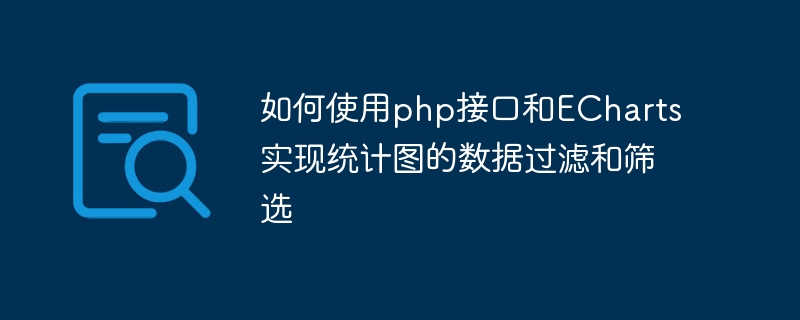Home >Backend Development >PHP Tutorial >How to use php interface and ECharts to implement data filtering and filtering of statistical charts
How to use php interface and ECharts to implement data filtering and filtering of statistical charts
- WBOYWBOYWBOYWBOYWBOYWBOYWBOYWBOYWBOYWBOYWBOYWBOYWBOriginal
- 2023-12-17 12:30:201578browse

How to use the PHP interface and ECharts to implement data filtering and screening of statistical charts
Overview:
ECharts is an excellent data visualization chart library, and PHP It is a commonly used server-side language. Combining the PHP interface and ECharts, we can use PHP to filter and screen the data, and then pass the filtered data to ECharts to generate corresponding statistical charts. This article will introduce in detail how to use the PHP interface and ECharts to implement this function, and provide specific code examples.
Step 1: Prepare data
First, we need some data to generate statistical charts. You can get data from a database or define an array of data directly in code. Here we take an array as an example. Suppose we have an array $data containing product names and sales. Each element is an associative array, where 'product' represents the product name and 'sales' represents the sales. The sample data is as follows:
$data = array(
array('product' => '产品A', 'sales' => 100),
array('product' => '产品B', 'sales' => 200),
array('product' => '产品C', 'sales' => 300),
// 其他数据...
);Step 2: Create a PHP interface
Next, we need to create a PHP interface to handle data filtering and filtering. We can conditionally filter the data by receiving parameters passed by the front end and return the filtered data. In this example, we will create an interface that takes the product name as a parameter. The sample code is as follows:
<?php
header("Content-Type: application/json"); // 设置响应头为JSON格式
$product = $_GET['product']; // 获取产品名称参数
$filteredData = array(); // 存储筛选后的数据
foreach ($data as $item) {
if ($item['product'] == $product) {
$filteredData[] = $item;
}
}
echo json_encode($filteredData); // 将筛选后的数据以JSON格式返回给前端Step 3: Create an HTML page
Next, we need to create an HTML page containing ECharts charts and front-end code. In the page, we can call the PHP interface through AJAX requests and pass the data returned by the interface to ECharts to generate statistical charts. The code example is as follows:
<!DOCTYPE html>
<html>
<head>
<meta charset="utf-8">
<title>数据过滤和筛选示例</title>
<!-- 引入ECharts库 -->
<script src="https://cdn.staticfile.org/echarts/5.1.2/echarts.min.js"></script>
</head>
<body>
<div id="chart" style="width: 600px; height: 400px;"></div>
<script>
var product = '产品A'; // 假设我们要筛选的产品是产品A
// 发起AJAX请求调用PHP接口
var xhr = new XMLHttpRequest();
xhr.open('GET', 'api.php?product=' + product, true);
xhr.onreadystatechange = function () {
if (xhr.readyState === 4 && xhr.status === 200) {
var data = JSON.parse(xhr.responseText); // 解析接口返回的JSON数据
// 使用ECharts生成统计图
var chart = echarts.init(document.getElementById('chart'));
chart.setOption({
xAxis: {
type: 'category',
data: data.map(item => item.product) // 数据的产品名称
},
yAxis: {
type: 'value'
},
series: [{
type: 'bar',
data: data.map(item => item.sales) // 数据的销售额
}]
});
}
};
xhr.send();
</script>
</body>
</html>In the above code, we first define the product name to be filtered as 'Product A', and then use AJAX request to call the PHP interface we created and pass the product name as a parameter to interface. The data returned by the interface will be parsed into JSON format and passed to ECharts to generate a histogram.
Summary:
Using the PHP interface and ECharts to implement data filtering and filtering of statistical charts can help us better display and analyze data. By creating a PHP interface to process data filtering and filtering, and passing the filtered data to ECharts to generate statistical charts, we can display different chart results according to different conditions and needs. The sample code given above can help you implement this functionality. You can modify and extend the code according to the actual situation to meet your needs.
The above is the detailed content of How to use php interface and ECharts to implement data filtering and filtering of statistical charts. For more information, please follow other related articles on the PHP Chinese website!

